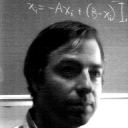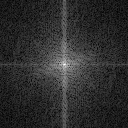|
|
|

|

|
"feels spatial" = "is spatial" is not an argument."
Unless you understand that what you are "feeling" is not just a feeling, it is the actual representation in your own brain!
"(And you have yet to tell us what a fourier transform would feel like.)"
A Fourier transform is a spatial image, just like the image of the world we see around us, except that instead of being organized spatially, it is organized on the basis of spatial frequency, with low spatial frequencies near the middle, and high spatial frequencies near the edges.
Here is an image, and its Fourier transform.
|
|
|

|

|
(Take a look at my on-line tutorial on Fourier theory for an intuitive explanation of this intriguing representation.)
We take it for granted that the world of experience is a spatial structure. But nature could just as well have chosen to use a Fourier representation instead, in which case our view of the world around us would appear as a pattern of brightness values that correspond to the Fourier components of the image of the world, as shown above, instead of the image itself, because the Fourier image contains all of the information contained in the original brightness image, so it can serve just as well as its spatial counterpart. Of course the Fourier image does not make much sense to us visually, but that is only because our neural hardware is tuned to interpret a spatial representation instead of a Fourier one.
In fact, in the auditory domain, our perceptual experience of sound is of a Fourier representation because we do not hear the actual oscillation of air pressure that defines the sound wave itself (except for the very lowest bass tones that are actually heard as a vibration), instead, we hear each frequency as a separate and distinct phenomenal variable, instead of a complex combination of waveforms which is what the actual auditory signal is. The fact that we can segment a musical chord into a set of discrete and distinct frequencies experienced simultaneously, instead of just a complex compound oscillation, is exactly because the cochlea performs a Fourier transform on the auditory signal, producing peak responses at discrete points along the Basilar membrane corresponding to the component frequencies of the compound stimulus waveform.